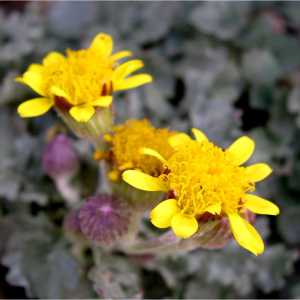 San Francisco groundsel (Packera franciscanus) is a low-growing species of perennial wildflower, that is only found in alpine tundra habitat in the San Francisco Peaks of Arizona. Several factors suggest the species could be particularly vulnerable to climate change.
San Francisco groundsel (Packera franciscanus) is a low-growing species of perennial wildflower, that is only found in alpine tundra habitat in the San Francisco Peaks of Arizona. Several factors suggest the species could be particularly vulnerable to climate change.
- San Francisco groundsel appears to possess adaptations that make it only competitive in cold alpine tundra climates and unable to persist in warmer climates. This is evidenced by its severely limited elevational distribution, from 11,300 ft to 12,400 ft (with the San Francisco Peaks topping out at 12,633 ft). The plant is limited to above 11,300 ft elevation despite possessing wind-dispersed seeds, which should give it ample opportunity to establish at lower elevations if conditions were suitable for the species.
- A primary mode of reproduction for San Francisco groundsel is clonal spreading via rhizomes. This suggests the plant could have low standing genetic diversity and limited ability to adapt to new conditions.
- Climate change appears poised to push suitable climate for San Francisco groundsel above the range of available habitat — suggesting that the species will have zero habitat with suitable climate by the end of the century. Here’s the back of the envelope math: The species has 1,333 ft between its lower elevational limit and the top of the peaks. At standard adiabatic lapse rate this sets the limit for the amount that temperatures can increase before the species’ climate envelope is pushed off the top of the mountain at 4.7°F. But even if governments take aggressive action to rein in greenhouse gas emissions (IPCC scenario B1, ensemble average) average temperatures on San Francisco Peak are predicted to rise by 4.6°F by 2080, with further increase in temperature by the end of the century. Under the business as usual (minimal action to rein in emissions, A2 scenario)– temperatures on San Francisco Peak are projected to rise by 8.3°F by 2080.
So it seems the species might be doomed. However, caveats to consider are: (1) It’s unclear what mechanisms limit the species lower elevation limit. Is it competition with other species (perhaps mediated by climate) or something else? Ecological processes that limit species distribution take time to unfold. (2) Lapse rates vary and high quality weather data from dispersed on-site weather stations would improve range shift estimates.